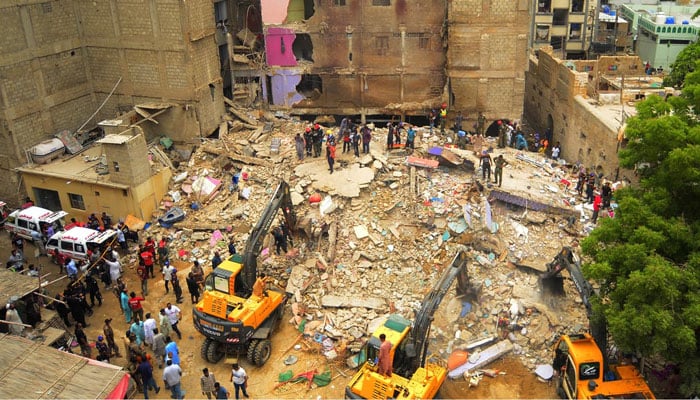
Rescue teams worked nonstop through the night and into Saturday after a five-storey residential building collapsed in Karachi’s Lyari area. The decades-old structure, located in the crowded Baghdadi neighborhood, crumbled on Friday, trapping dozens under debris.
Authorities believe 10 to 12 people might still be stuck beneath the rubble. So far, 16 bodies have been recovered — six women and ten men. Three people remain under treatment, according to hospital officials.
Equipped with heavy machinery and Trapped Person Locator devices that detect heartbeats, rescue workers carefully remove layers of concrete. However, emotional scenes unfolded as desperate relatives attempted to help, inadvertently interfering with the ongoing mission. Rangers and city wardens later stepped in to secure the area and assist in crowd control.
Deputy Commissioner Javed Khoso revealed that the building had been declared dangerous three years ago, and formal notices were issued as recently as six weeks back. Despite warnings, the building remained occupied, housing over 40 residents in 20 flats.
Five Killed, Seven Injured in Karachi’s Lyari Building Collapse
Evacuation Orders Ignored, Legal Action Looms
Officials now admit the collapse could have been prevented. Karachi Commissioner Syed Hassan Naqvi, during his late-night visit to the site, urged residents of similarly unsafe buildings to relocate immediately. However, he acknowledged the legal limitation, saying authorities cannot forcefully evict tenants.
The Sindh Building Control Authority (SBCA) disclosed that the structure had been officially marked unsafe years ago. Evacuation notices were issued multiple times. Even utility companies like K-Electric and the Water Board were asked to cut services — but failed to act. This negligence has raised serious questions about enforcement and accountability.
Currently, there are 22 such “extremely dangerous” buildings in Lyari alone. Of these, 16 have been evacuated while the rest remain occupied. The deputy commissioner has warned of legal consequences for non-compliance, highlighting the urgent need for stronger implementation.
A high-level committee formed by the Sindh government has begun its investigation and is expected to submit a report within three days. However, critics argue that such probes often end with little action and call for immediate reforms.
Unsafe Buildings Haunt Karachi
This is not the first such tragedy. Karachi has faced repeated incidents of building collapses, especially since 2017. The root cause lies in a dangerous mix of illegal construction, poor regulation, and neglected maintenance.
The SBCA reports that 578 buildings across Karachi have been marked unsafe — with a staggering 456 located in District South alone. Other districts face similar threats: Central (66), Keamari (23), Korangi (14), East (13), Malir (4), and West (2).
Experts argue that placing banners or issuing notices isn’t enough. Stronger steps are essential, including compulsory evacuations and temporary shelters for affected families. Without immediate and effective action, such tragedies will continue to unfold in Pakistan’s largest city.
Follow us on Instagram, YouTube, Facebook, X and TikTok for latest updates




